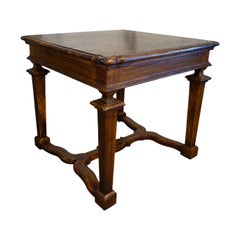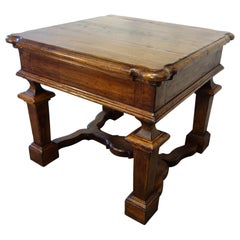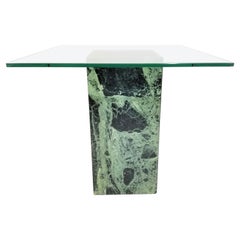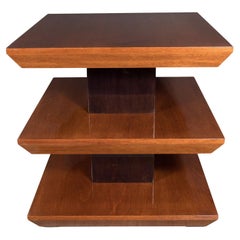Bellini's Antique Italia End Tables
to
Height
to
Width
to
Depth
to
2
2
1
1
2
2
1
1
2
2
2
Mid Century Mediterranean Style Italian Custom Handcrafted PORTOFINO Table Line
Located in Encinitas, CA
The “Portofino” table line style is one of a splendid selection of Tuscan/Mediterranean, Rustic, Primitive, Farmhouse & Classic table styles. This Portofino side/end/occasional table...
Category
2010s Italian Mid-Century Modern End Tables
Materials
Poplar
19th C Mediterranean Style PORTOFINO Old Walnut Table Size & Finish Options
Located in Encinitas, CA
PORTOFINO Mid Century Mediterranean Style Italian Custom Handcrafted Table Line
Introducing our re-designed Mediterranean style "Portofino" table line - the authentic Italian art & handcraft of fine, custom antique reproduction. Reminiscent of late 1950s-early 1960s Mediterranean style designs, our new "Portofino" table style shown in Old Walnut is the slim-line version of our original heavier Tuscan style Portofino table line. (See our 19th Century Tuscan style Portofino Old Walnut table...
Category
2010s Italian Baroque End Tables
Materials
Walnut
Related Items
Belgian Marble and Glass Table Mid Century, 1970s
Located in New York, NY
Mid century 1970s - 1980s green marble base with glass top end table or side table. Beautiful beveled substantial glass. Dark brown/ black l...
Category
Mid-20th Century European End Tables
Materials
Marble
Custom by High Style Deco 3-Tier Art Deco Style Table in Walnut & Black Lacquer
Located in New York, NY
This elegant skyscraper style side table was realized custom by High Style Deco in the 21st Century. It features three square tiers that recede downwards at angle from their squared ...
Category
21st Century and Contemporary American Art Deco End Tables
Materials
Walnut, Lacquer
$5,475
H 28.5 in W 28 in D 28 in
Late 19th Century Spanish Walnut Side Table
Located in Miami, FL
Walnut side table from the 19th century from Spain with a plank top, around the chest of drawers a hand-carved decorated molded edge and a drawer with very old iron handles, on the s...
Category
Antique Late 19th Century Spanish Baroque Side Tables
Materials
Walnut
Sculptural Mid-Century Modern End Tables after Adrian Pearsall
By Gio Ponti, Adrian Pearsall
Located in Philadelphia, PA
An unusual matching pair of two-tier end tables from the 1960's. They feature walnut construction with floating glass tops.
In the style of: Adrian Pearsall, Gio Ponti
Category
Vintage 1960s Unknown Mid-Century Modern End Tables
Materials
Walnut
1970's Mid-Century Modern Hodges Mersman End Table
By Mersman
Located in Lake Worth, FL
For FULL item description be sure to click on CONTINUE READING at the bottom of this listing.
A NOTE ABOUT SHIPPING: The shipping charge and shipping details shown in the listing are set by 1stDibs. We may be able to offer you a lower shipping cost and shorter shipping time on some of our items. Please ask us for details.
Offering One Of Our Recent Palm Beach Estate Fine Furniture Acquisitions Of A
1970's Mid Century Modern Hodges Mersman...
Category
Vintage 1970s Mid-Century Modern End Tables
Materials
Smoked Glass, Oak
19th C. French Charles X Restoration Period Sewing Stand Work Table
Located in Forney, TX
A scarce period Charles X (1818-1834) French Restoration mahogany travailleuse sewing (thread stand - side table - jewelry dressing table) with light, warm, beautifully aged patina.
Born in France in the early 19th century, almost certainly Parisian work, exquisitely hand-crafted, this exceptionally executed example features ornate gilt bronze ormolu mounts, escutcheons, and elaborate gilt metal trim. Having a highly figured light mahogany hinged lid top, lifting open to reveal a striking finished interior with divided compartments and original inset mirror plate. The conforming rectangular case fitted with a faux drawer front over a dovetailed drawer with sectioned interior. Elegantly rising on oval-shaped medial shelf stretcher-joined curvacious legs.
Dimensions (approx):
27" High, 20" Wide, 13.5" Deep
Stunning light almost blonde antique mahogany coloring and mellow warm tone, superb wood grain detail, and charming, beautifully aged patina over the whole. Great shape overall. Retaining original antique character marks, wear consistent with age and indicative of minimal use, nothing that detracts from the aesthetics or functionality, but only adds to the overall authenticity, refined elegant warmth, luxurious sophistication, and cozy unpretentious rustic elegance.
Delivered cleaned, hand waxed, polished French patina finish, ready for immediate use and generational enjoyment!
What is Charles X style:
The comte d’Artois – or Charles X - was the son of the dauphin Louis-Ferdinand de Franc and Marie-Josèphe de Saxe. He succeeded his two brothers Louis XVI and Louis XVIII and became the King of France in 1824. Thirty years after the French Revolution, he wanted to embody the return of monarchy and became the leader of the catholic party . As the previous kings, he was crowned in 1825 but he was soon overthrown by the revolution in July, 1830, called "Trois Glorieuses". He left then for England, Scotland, Prague and Istria where he died in 1836.
Charles X style lasted from 1818 to 1834 and happened during the Bourbon Restoration (French Restoration). This style did not replace totally the style of furniture from the French Empire but it was different from the formalism in the Napoleonic era, during which strictness and simplicity were inspired by Greco-Roman art. Indeed, artistic fields flourished. In terms of furniture, this renewal was suggested by the softening of shapes. Even though the simple aspect from the French Empire was still visible, shapes became curvier with volutes and arabesques. Another distinction is the loss of the massive aspect of furniture and the decrease of dimensions in order to decorate smaller appartments. Handling ability and comfort were key-words in the making of furniture. Apartments had essential elements such as chests of drawers, big rounded tables in the dining room, desks or secretaries, armoires and even dressing tables, comfortable fainting couches in the living room, small tables, pedestal tables, as well as gondola chairs. The wavy aspect of the latters certainly represent Charles X style the best.
One of the most emblematic features of this style is the use of bois clairs – light woods in warm blond tones - and indigenous woods that are varnished in order to highlight the grains. Bird's-eye maple, ash trees, plane trees, yew trees, beech trees, olive trees and cedar trees were most likely to be used. Indeed, at the beginning of the 19th century dark woods were hard to find. In 1806, the Napoleon’s Continental System was established in order to ruin the United Kingdom by preventing the country from any business with the rest of Europe. Therefore craftsmen had to find alternatives from mahogany which was the most commonly used material at this time. After 1815, the import of wood was even more difficult because of peace treaties and the European political situation, which contributed to the popularity of the bois clairs and indigenous woods. The furniture was often decorated with fine inlays made out of dark wood representing foliage, which contrasted with the veneer. Even though these patterns can look like bronze decorations from the Empire era, they were far more simple and did not represent any military or mythological attributes. On the tables, trays were sometimes made out of marble as in the French Empire, but it was often put aside and inlaid veneer, Verre Eglomisé – a type of glass with a mirror finish –, mirror or porcelain from Sèvres or Paris were more likely to be used.
Decorative elements from the Monarchy were highly appreciated again as they suggested luxury. Indeed, marquetry work was particularly fashionable - Boulle marquetry thrived around 1820 as the works of the Levasseur family can show. In the same way, draperies and trimmings referred to the monarchist splendour. Fabrics were often white – the traditional colour of the Bourbons – or light coloured as oppposed to the typical green from the Napoleonic era.
One of the most symbolic figures from this period of time might be Jean-Jacques Werner (1791-1849), a cabinetmaker who worked for prestigious clients such as the Duchesse de Berry who was Charles’s step-daughter. His works can be seen at the Musée des Arts Décoratifs and at the Grand Trianon in the Palace of Versailles. The duchess’s appartments situated at the pavillon de Marsan and at the Palais de Saint Cloud illustrate Charles X style the best with furniture made out of bois clairs and ornamented with dark wood patterns or fine gold decorations.
Chales X style allows a transition between the sobriety of the Empire style and the abundant aspect of Louis-Philippe style. The gothic style started at this time through the "style à la cathédrale", inspired by religious architecture, which thrived from 1827 to 1830. Indeed, at the beginning of the 19th century, Romanticism put the spotlight on the Middle Ages. Cabinetmakers were not inspired by the medieval furniture but rather by architectural elements of churches and cathedrals. For instance the backs of chairs were decorated with arches shaped like rib and serration. In the same way, before Charles X abdicated, pieces of furniture were made out of dark woods – such as mahogany, which was used again in France – and were inlaid with light wood. Romanticism also influenced the layout of furniture in appartments to suggest movement through a mix of various styles, various shapes and various sizes, as opposed to the static aspect of Neoclassicism. The start of industrialisation and mechanisation also influenced this style as early technical developments led to the production of pieces of furniture in series.
Credit:
Marc Maison
Bibliography:
FANIEL Stéphane (Dir.), Le Dix-neuvième Siècle Français, Collection Connaissance des Arts, 1957, Hachette
SASSONE, Adriana Boidi, Furniture from Rococo to Art Deco, 2000, Evergreen
--
Extremely versatile:
As warm and attractive as it is useful, this remarkable antique table having the ideal size and small proportions for a variety of different uses, including as a side table, accent or occasional table, tall sofa...
Category
Antique Early 19th Century French Charles X End Tables
Materials
Bronze, Ormolu
Bedside Table in White Ash with Oil Finish
By Brian Holcombe
Located in Princeton, NJ
Contemporary take on Sashimono furniture, utilizing carefully handmade interlocking joinery. This nightstand features a drawer made with handcut dovetailed construction. In traditional Sashimono drawers are made to fit and function in very exacting fashion, this drawer uses...
Category
2010s North American End Tables
Materials
Ash
Pair of Mid-Century Modern Sled Leg End Tables
Located in Brooklyn, NY
A stunning pair of vintage modern end tables with floating style glass tops with bevelled edges. Heavy metal bases and thick glass tops with a light tint of green adds to the midcent...
Category
Vintage 1970s Mid-Century Modern End Tables
Materials
Metal
Baroque-Style Table, 19th / 20th Century
Located in Greding, DE
Baroque-style table in solid walnut, with rectangular table top on curved cut-out legs and curved iron intermediate strut.
Category
Antique 19th Century Baroque Tables
Materials
Wood
Italian Baroque Style Walnut Table
Located in Essex, MA
Rectangular top with old crack over a trestle base with wrought iron stretchers. Old elements.
Category
Antique 17th Century Italian Baroque End Tables
Materials
Walnut
19th Century Walnut Wine Table
Located in Houston, TX
Walnut folding vendange table. France, circa 1870. Measurements: H: 28" W: 31.75"
Category
Antique 19th Century French End Tables
Materials
Walnut
A Custom Mahogany End/Side Table with Parchment Top and Central Drawer
Located in New York, NY
A custom mahogany end table with parchment top featuring a central drawer.
Lead Time for custom-made is 8-10 weeks.
Category
21st Century and Contemporary American End Tables
Materials
Mahogany, Parchment Paper
$9,500 / item
H 24 in W 18 in D 18 in



